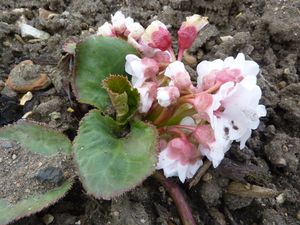Note: This is a project under development. The articles on this wiki are just being initiated and broadly incomplete. You can Help creating new pages.
Bergenia ligulata - Asmabhedaka
Bergenia ligulata is a plant belonging to the family Saxifragaceae and the genus Bergenia. The plant is mostly found in temperate Himalayas from Kashmir to Bhutan and in Khasia hills at 15,00 meter altitude.
Contents
- 1 Uses
- 2 Parts Used
- 3 Chemical Composition
- 4 Common names
- 5 Properties
- 6 Habit
- 7 Identification
- 8 List of Ayurvedic medicine in which the herb is used
- 9 Where to get the saplings
- 10 Mode of Propagation
- 11 How to plant/cultivate
- 12 Commonly seen growing in areas
- 13 Photo Gallery
- 14 References
- 15 External Links
Uses
Teething troubles, Ear pain, Intestinal parasites, Cuts, Boils, Wounds, Burns, Dysentery, Fever, Cough.
Parts Used
Chemical Composition
Bergenia ligulata contains A phenolic compound bergenin and afzelechin, a type of flavan-3-ol. The rhizome contains an active principle bergenin (0.6%), gallic acid, glucose (5.6%), tannins (14.2–16.3%), mucilage and wax; a C-glycoside and beta-sitosterol.[1]
Common names
| Language | Common name |
|---|---|
| Kannada | Alepgaya, Hittaga, Hittulaka |
| Hindi | Dakachru, Pakhanabhed |
| Malayalam | Kallurvanchi,Kallurvanni |
| Tamil | Sirupilai |
| Telugu | Kondapindi, Telanurupindi |
| Marathi | NA |
| Gujarathi | NA |
| Punjabi | NA |
| Kashmiri | NA |
| Sanskrit | Ashmabheda,Nagbhita |
| English | Velvet leaf |
Properties
Reference: Dravya - Substance, Rasa - Taste, Guna - Qualities, Veerya - Potency, Vipaka - Post-digesion effect, Karma - Pharmacological activity, Prabhava - Therepeutics.
Dravya
Rasa
Guna
Veerya
Vipaka
Karma
Prabhava
Habit
Identification
Leaf
| Kind | Shape | Feature |
|---|---|---|
| Ovate | Rounded | Large rounded basal leaves with untoothed bristly margins |
.[2]
Flower
| Type | Size | Color and composition | Stamen | More information |
|---|---|---|---|---|
| Unisexual | 1.5-2.5 cm long | White–violet | With 5 petals | Sepal cup is hairless with blunt sepals |
Fruit
| Type | Size | Mass | Appearance | Seeds | More information |
|---|---|---|---|---|---|
| 7–10 mm (0.28–0.4 in.) long pome | {{{6}}} |
Other features
List of Ayurvedic medicine in which the herb is used
Where to get the saplings
Mode of Propagation
How to plant/cultivate
Bergenia are hardy plants that can grow in climates with extreme temperature ranges from about −35 °F (−37 °C) to 115 °F (46 °C).[4]
Commonly seen growing in areas
Photo Gallery
References
External Links
- Ayurvedic Herbs known to be helpful to treat Teething troubles
- Ayurvedic Herbs known to be helpful to treat Ear pain
- Ayurvedic Herbs known to be helpful to treat Intestinal parasites
- Ayurvedic Herbs known to be helpful to treat Cuts
- Ayurvedic Herbs known to be helpful to treat Boils
- Ayurvedic Herbs known to be helpful to treat Wounds
- Ayurvedic Herbs known to be helpful to treat Burns
- Ayurvedic Herbs known to be helpful to treat Dysentery
- Ayurvedic Herbs known to be helpful to treat Fever
- Ayurvedic Herbs known to be helpful to treat Cough
- Herbs with Roots used in medicine
- Herbs with Rhizomes used in medicine
- Herbs with Leaves used in medicine
- Herbs with common name in Kannada
- Herbs with common name in Hindi
- Herbs with common name in Malayalam
- Herbs with common name in Tamil
- Herbs with common name in Telugu
- Herbs with common name in Sanskrit
- Herbs with common name in English
- Habit - Herb
- Index of Plants which can be propagated by Seeds
- Index of Plants which can be propagated by Tuber segment
- Herbs that are commonly seen in the region of Trophical areas
- Herbs that are commonly seen in the region of Cold areas
- Herbs
- Ayurvedic herbs that don't have flower, fruit and leaf photos
- Ayurvedic herbs that don't have seed photos
- Saxifragaceae



